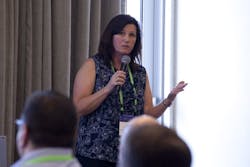Asset management is a hot topic for manufacturers trying to squeeze as much cost out of their plant floor as possible. Of course, in today’s competitive climate, it’s not just about saving money, but also about meeting reliability, safety and performance goals for machinery, production lines and the entire plant.
During a presentation at Schneider Electric’s Innovation Summit: Software Conference 2017 earlier this month, Kim Custeau, Schneider’s director of asset management, explained how the company’s own digital transformation will help manufacturers in their overall asset management journey. According to Custeau, Schneider Electric’s products are being integrated in a holistic way for a cohesive approach when managing assets throughout their lifecycles.
The company’s Asset Performance Management (APM) software connects DCS, PLC, SCADA, sensors and advanced distribution management system (ADMS). It then collects online process data and production information. It analyzes the data. And, then acts on it.
For each of these areas—connect, collect, analyze and act—Schneider Electric has a plan. Moving forward, the company will incrementally add digestible components to the app to solve specific problems across the asset spectrum, Custeau said. “The next generation will rethink how people interact with the apps,” she said.
Some future functionality of APM will include speed improvements around data collection. It will be cloud-enabled, have enhanced diagnostics, more mobility and offer augmented and virtual reality. But the one area that has not been part of the strategy—until now—is the ability to perform risk-based management.
Schneider Electric recently announced a partnership with MaxGrip, adding assessment services that help an organization understand the impact critical assets have on a process, and align that with corporate goals to determine how to collect data.
As a result of this partnership, Schneider Electric can offer enhanced APM capabilities that allow customers to optimize maintenance execution according to asset criticality. Risk analysis, what-if analysis and asset management review provide insight into asset reliability and performance, facilitating long-term strategic planning.
In addition, users can optimize operations by eliminating reoccurring incidents with root cause analysis, inventory management and simulations to identify hidden inefficiencies to drive value across the enterprise. According to the company, an extensive library of asset reliability data and templates allows up to 90 percent faster time to deployment.
“Once you manage risk, you can optimize processes,” said Jim Chappell, Schneider Electric’s vice president of information solutions.
Moving forward, processes will be managed in a hybrid cloud set up, where investments made on premise will remain, and some applications move to the cloud. “We are putting an effort into the design of this so it is simple and effortless,” Chappell told attendees at the conference.
It will also be fast. The next release of Wonderware Historian will be 200 times faster for large queries. The eDNA Historian will be cloud-enabled with enhanced object and data modeling and event framing, so when an anomaly occurs, it will proactively alert you. There will also be expanded types of content, asset hierarchies, integrated apps and collaboration.
For the mobile operator, IntelaTrac, will be cloud-enabled to pull data online thereby enabling augmented reality (AR) overlays for training purposes, or to query the cloud for information surrounding the asset. Device support will also expand to Android and iOS, and will be able to manage global time zones.
Now, what to do with the data? Using multi-dimensional data modeling at the site or enterprise level, everything can be contextualized in the cloud. Once the information is collected and modeled, Schneider Electric’s Predictive Asset Analytics Software, called PRiSM, will be able to predict anomalies, starting with the digital twin. By taking the digital twin information and running it against historical data, it can come up with a digital footprint to predict correlations between conditions using multi-dimensional analysis.
The software may just look at small issues, but it can make a big difference. For example, at a large utility company, identifying a hairline fracture in a turbine blade saved the company $7.5 million. “It was a small anomaly in the data that determined it needed to be replaced, which was a big savings for that organization,” Custeau said.
Next year, PRiSM will include an algorithm that adds not only predictive, but prescriptive and risk-based prognostics.
Ultimately, every major area of the APM portfolio will be upgraded with some common functionality around the hybrid cloud, visualization and analytics. The goal is to safeguard business continuity.
“We are developing a strategy that balances risk, cost, people, technology, systems and process,” Custeau said.

